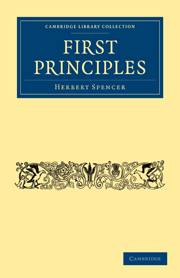Book contents
- Frontmatter
- PREFACE
- Contents
- PART I THE UNKNOWABLE
- PART II LAWS OF THE KNOWABLE
- I LAWS IN GENERAL
- II THE LAW OF EVOLUTION
- III THE LAW OF EVOLUTION (CONTINUED)
- IV THE CAUSES OF EVOLUTION
- V SPACE, TIME, MATTER, MOTION, AND FORCE
- VI THE INDESTRUCTIBILITY OF MATTER
- VII THE CONTINUITY OF MOTION
- VIII THE PERSISTENCE OF FORCE
- IX THE CORRELATION AND EQUIVALENCE OF FORCES
- X THE DIRECTION OF MOTION
- XI THE RHYTHM OF MOTION
- XII THE CONDITIONS ESSENTIAL TO EVOLUTION
- XIII THE INSTABILITY OF THE HOMOGENEOUS
- XIV THE MULTIPLICATION OF EFFECTS
- XV DIFFERENTIATION AND INTEGRATION
- XVI EQUILIBRATION
XI - THE RHYTHM OF MOTION
Published online by Cambridge University Press: 29 August 2010
- Frontmatter
- PREFACE
- Contents
- PART I THE UNKNOWABLE
- PART II LAWS OF THE KNOWABLE
- I LAWS IN GENERAL
- II THE LAW OF EVOLUTION
- III THE LAW OF EVOLUTION (CONTINUED)
- IV THE CAUSES OF EVOLUTION
- V SPACE, TIME, MATTER, MOTION, AND FORCE
- VI THE INDESTRUCTIBILITY OF MATTER
- VII THE CONTINUITY OF MOTION
- VIII THE PERSISTENCE OF FORCE
- IX THE CORRELATION AND EQUIVALENCE OF FORCES
- X THE DIRECTION OF MOTION
- XI THE RHYTHM OF MOTION
- XII THE CONDITIONS ESSENTIAL TO EVOLUTION
- XIII THE INSTABILITY OF THE HOMOGENEOUS
- XIV THE MULTIPLICATION OF EFFECTS
- XV DIFFERENTIATION AND INTEGRATION
- XVI EQUILIBRATION
Summary
§ 93. When the pennant of a vessel lying becalmed first shows the coming breeze, it does so by gentle undulations that travel from its fixed to its free end. Presently the sails begin to flap; and their blows against the mast increase in rapidity as the breeze rises. Even when, being fully bellied out, they are in great part steadied by the strain of the yards and cordage, their free edges tremble with each stronger gust. And should there come a gale, the jar that is felt on laying hold of the shrouds shows that the rigging vibrates; while the rush and whistle of the wind prove that in it, also, rapid undulations are generated. Ashore the conflict between the current of air and the things it meets results in a like rhythmical action. The leaves all shiver in the blast; each branch oscillates; and every exposed tree sways to and fro. The blades of grass and dried bents in the meadows, and still better the stalks in the neighbouring corn-fields, exhibit the same rising and falling movement. Nor do the more stable objects fail to do the like, though in a less manifest fashion; as witness the shudder that may be felt throughout a house during the paroxysms of a violent storm. Streams of water produce in opposing objects the same general effects as do streams of air. Submerged weeds growing in the middle of a brook, undulate from end to end.
- Type
- Chapter
- Information
- First Principles , pp. 313 - 334Publisher: Cambridge University PressPrint publication year: 2009First published in: 1862



